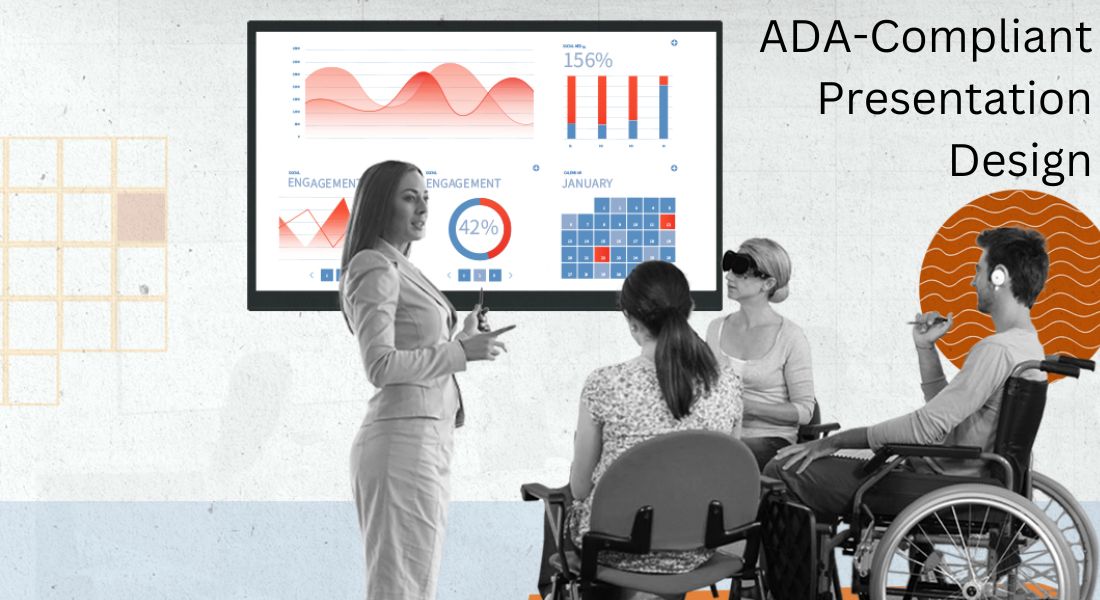
In today's corporate environment, ensuring that presentations are accessible to all audiences is not just a legal obligation but a moral imperative. With the rise in awareness and emphasis on inclusivity, organizations increasingly focus on Presentation ADA Compliance to ensure their content is accessible to everyone, including individuals with disabilities. This blog explores the best practices for creating ADA-compliant corporate presentations, ensuring that your message is clear and accessible to all.
Understanding ADA Compliance in Presentations
The Americans with Disabilities Act (ADA) sets the standards for ensuring that people with disabilities have equal access to services, including digital content such as presentations. When discussing ADA compliance in presentations, we refer to the design and delivery methods that make the content accessible to individuals with visual, auditory, cognitive, or motor impairments. This involves using tools like screen readers, providing text alternatives for images, ensuring that video content is captioned, and designing slides with appropriate contrast and font sizes.
Corporate presentations often contain complex data and visual elements, making Presentation ADA Compliance challenging yet essential. Ensuring that your presentation meets these standards broadens your audience and demonstrates your organization's commitment to inclusivity. By adhering to ADA compliance in presentations, businesses can avoid legal pitfalls and foster an environment of accessibility and equality.
Best Practices for Creating ADA Compliant Corporate Presentations
Creating an ADA compliant corporate presentation involves several key practices. Firstly, use descriptive text for all images, charts, and graphs. This allows screen readers to convey the information to visually impaired users. Additionally, ensure that all text is legible by using high-contrast color schemes and large, readable fonts. The minimum recommended font size is 18 points, but this can vary depending on the font style and the overall design of the slide.
Another critical aspect of Presentation ADA Compliance is ensuring that videos and audio clips within the presentation include captions and transcripts. This is crucial for individuals who are deaf or hard of hearing. Moreover, the structure of the presentation should be straightforward, with a logical flow that is easy to follow. Avoid complex animations or transitions that can be distracting or difficult to navigate for individuals using assistive technologies. Consistency in slide layout also contributes to ADA compliance in presentations, as it allows users to anticipate the content structure.
Implementing ADA Compliance in Corporate Presentations
Implementation of ADA compliance in presentations requires both a proactive approach during the design phase and thorough testing before the presentation is delivered. Start by using templates that are already optimized for accessibility. These templates often include guidelines on font size, color contrast, and the use of alt text for images. It's also important to regularly test your presentations with screen readers and other assistive technologies to ensure that all content is accessible.
Corporate teams should also be trained on the principles of Presentation ADA Compliance. This includes understanding how to create accessible content and recognizing the importance of testing for accessibility. Collaboration with IT and accessibility experts can further enhance the accessibility of corporate presentations. Additionally, offering alternative formats, such as text-only versions or providing the presentation content in advance, can significantly improve accessibility for individuals with disabilities.
The Business Case for ADA Compliant Presentations
While ADA compliance in presentations is legally required, it also offers significant business advantages. Accessible presentations ensure that all stakeholders, including employees, clients, and partners, can engage with the content, leading to better communication and collaboration. Furthermore, companies that prioritize Presentation ADA Compliance demonstrate their commitment to diversity, equity, and inclusion, which can enhance their brand reputation and attract top talent.
Investing in ADA compliant corporate presentations can also mitigate the risk of legal challenges and penalties associated with non-compliance. As more businesses adopt remote and hybrid working models, the need for accessible digital content has never been greater. By adhering to ADA compliance in presentations, companies can ensure that they are meeting the needs of all their audience members, regardless of their abilities.
Conclusion
Creating ADA compliant corporate presentations is not just about meeting legal requirements; it's about fostering an inclusive environment where everyone has equal access to information. By implementing best practices for Presentation ADA Compliance, organizations can ensure their presentations are accessible, effective, and legally compliant. This not only enhances the reach and impact of your presentations but also demonstrates a strong commitment to inclusivity and diversity in the workplace.
Ensuring ADA compliance in presentations may require an investment of time and resources, but the benefits far outweigh the costs. In today's increasingly digital and diverse world, accessibility is key to effective communication and business success. As we move forward, the emphasis on Presentation ADA Compliance will continue to grow, making it an essential component of any corporate communication strategy.










Comments (0)